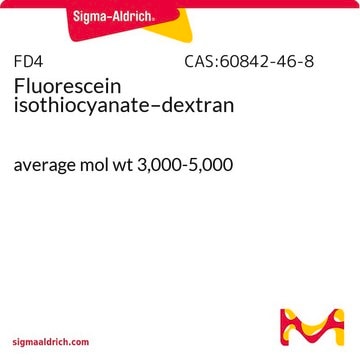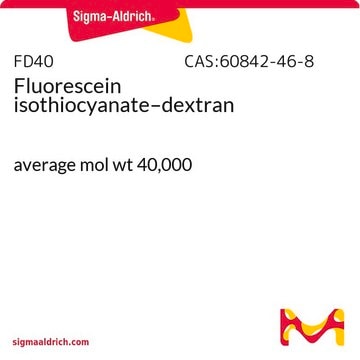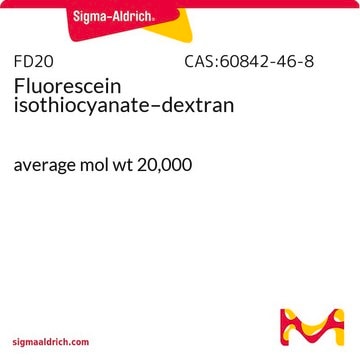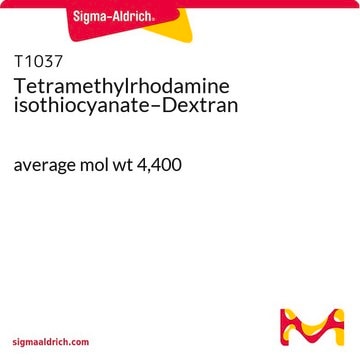Once Fluorescein isothiocyanate-dextran (item 46944) is in solution, it is recommended to store it at -20ºC and utilize it within 3 months to maintain its potency. To prevent multiple freeze/thaw cycles, it is advisable to aliquot the solution.
46944
Isotiocianato de fluoresceína-dextrano
average mol wt 4,000, (FITC:Glucose = 1:250)
Sinónimos:
FITC- Dextrano 4, FITC–Dextrano
Seleccione un Tamaño
177,00 €
Seleccione un Tamaño
About This Item
177,00 €
Productos recomendados
mol peso
average mol wt 4,000
Nivel de calidad
composición
(FITC:Glucose = 1:250)
Extensión del etiquetado
~0.004 mol/mol FITC glucose
solubilidad
H2O: 50 mg/mL, slightly hazy, orange
temp. de almacenamiento
2-8°C
¿Está buscando productos similares? Visita Guía de comparación de productos
Aplicación
El FITC-dextrano se utiliza en investigación cardiovascular, microcirculatoria, de la perfusión, de la permeabilidad de monocapas celulares y de la membrana celular como compuesto fluorescente trazador del flujo que sustenta la medición de procesos como el flujo sanguíneo, el daño de las membranas, el drenaje vascular y la eliminación renal
El isotiocianato de fluoresceína-dextrano (FITC-dextrano 4) se utiliza como una sonda fluorescente para estudiar la permeabilidad celular. El FITC-dextrano 4 se utiliza para estudiar la permeabilidad de las células epiteliales, como las células intestinales y renales in vivo.
Envase
Producto relacionado
Palabra de señalización
Warning
Frases de peligro
Consejos de prudencia
Clasificaciones de peligro
Eye Irrit. 2 - Skin Irrit. 2 - STOT SE 3
Órganos de actuación
Respiratory system
Código de clase de almacenamiento
11 - Combustible Solids
Clase de riesgo para el agua (WGK)
WGK 3
Punto de inflamabilidad (°F)
Not applicable
Punto de inflamabilidad (°C)
Not applicable
Equipo de protección personal
Eyeshields, Gloves, type N95 (US)
Elija entre una de las versiones más recientes:
¿Ya tiene este producto?
Encuentre la documentación para los productos que ha comprado recientemente en la Biblioteca de documentos.
Los clientes también vieron
Contenido relacionado
Dextran is a polymer of anhydroglucose. It is composed of approximately 95% alpha-D-(166) linkages. The remaining (163) linkages account for the branching of dextran.
-
What is the recommended storage method for stock solutions of item 46944, Fluorescein isothiocyanate-dextran?
1 respuesta-
¿Le ha resultado útil?
-
-
At what excitation and emission wavelengths should Product No. 46944, Fluorescein isothiocyanate-dextran, be read?
1 respuesta-
The excitation maximum for FITC-dextran is 490 nm, while the emission maximum is 520 nm.
¿Le ha resultado útil?
-
-
Are there any fluorescent hydrophobic substitutes of similar size to FITC dextran (4,000 amu) available, considering regular dextran lacks fluorescence and is hydrophilic?
1 respuesta-
There is only one dextran conjugated with a hydrophobic fluorescent dye. The TRITC dextran, T4037, has an average dextran weight of 4,400 amu and TRITC is slightly more hydrophobic than FITC.
¿Le ha resultado útil?
-
-
After reconstitution, how can we sterilise the dextran solution?
1 respuesta-
The FITC-Dextran solution can be sterilized by filtration.
¿Le ha resultado útil?
-
-
What is the stability of FITC-dextran in vivo?
1 respuesta-
These products are not tested on animals. Reports suggest a 24-hour in vivo stability.
¿Le ha resultado útil?
-
Filtros activos
Nuestro equipo de científicos tiene experiencia en todas las áreas de investigación: Ciencias de la vida, Ciencia de los materiales, Síntesis química, Cromatografía, Analítica y muchas otras.
Póngase en contacto con el Servicio técnico












